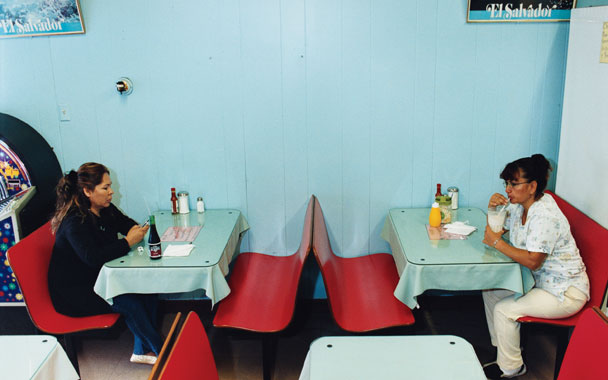On May Day of this year, images from MacArthur Park in Los Angeles, the heart of Salvadoran America, flashed across millions of TV screens. It was not a pretty sight. At the culmination of a rally commemorating last year’s immigrants’ rights marches, phalanxes of LAPD officers fired dozens of rubber bullets and used their nightsticks on a crowd that included grandmothers and babies. I watched the coverage and sighed. Little Central America never gets a break, either on the streets or in the media.
Some 15 years after the end of the civil war in El Salvador, most Americans still think of Salvadorans as either victims or perpetrators of violence. During the conflict, terror-inducing U.S.-backed death squads loomed large in our imagination. Today, the Salvadoran figure in the American media is the transnational gangbanger, as in the representation of the Mara Salvatrucha, the “most dangerous gang in the world,” in Lisa Ling’s recent National Geographic Channel “documentary.”
¡Ay, El Salvador! You deserve a great sad Mexican song that says ¡Ay, El Salvador! (You see, I am half Salvadoran, but I am also half Mexican; so I can patronize both peoples.) But El Salvador doesn’t really need anyone to speak for it. It is renowned in Latin America for its literature, in particular its poetry. Roque Dalton, the national bard, is revered for his exploits both on the page and off. (He survived prison, exile, and crude Marxist training only to be assassinated by leftist comrades a few years before the civil war broke out.)
So I will write you of Salvadorans not merely as war babies or gangbangers or revolutionaries stuck with a bad 1980s sound track and even worse haircuts. I will write you of how, in spite of conquistadores and fascists and U.S.-backed death squads in El Salvador, and of patronizing liberals and cutthroat conservatives and crooked cops in America, Salvadorans have resisted, have survived, and have established themselves in the heart of most of our cities and even in small towns—and especially in my hometown, the new-immigrant Mecca, the city led by a beaming, twinkly-eyed son of immigrants, the brown town of Los Angeles.
And I must emphasize just how brown this town is now. The 2005 Census estimate shows the city’s Hispanic population at 49 percent, and demographers agree that the plurality is now a majority, the official designation forthcoming in 2010. There are more than 600,000 Central Americans in Los Angeles County, the majority from El Salvador, a decidedly minority population relative to Mexicans, but a strong presence nonetheless in immigrant-heavy Southern California. There are more than one and a quarter million Salvadorans spread throughout the country; most arrived during the civil war, but they have continued to come.
With their numbers and urban energy, Salvadorans (along with their Guatemalan, Honduran, and Nicaraguan counterparts) are an integral part of the demographic revolution that has remade Los Angeles in the last generation. I grew up in a city that was utterly Anglo and whose rules were brutally enforced by a police department that brilliantly used the cover of the antiseptic image promoted by TV fantasies like Dragnet. (Realtors literally referred to Los Angeles as the “whitest” city in America, less than ten decades after the Mexican-American War and its aftermath of ethnic purging.) Although the LAPD can act as if we’re still in the mid-20th century—as the May Day debacle underscored—that city no longer exists. History has come full circle, moved by people on the move.
MacArthur Park was the gateway for the great influx of refugees in the early 1980s, a Los Angeles version of New York’s Lower East Side, with old brick-and-fire-escape tenements and a population density that, by the end of the decade, actually surpassed that of Manhattan. I was in my early twenties when the refugees began arriving, a young writer looking for a thematic home. I’d grown up middle-class, in rather bizarre cultural circumstances: the aforementioned Mexican-Salvadoran background set in the WASP city, an experience of far too many contradictions—those between Mexican and Salvadoran being just one of them. (Salvadorans resent Mexicans for the barbaric treatment Salvadorans receive as they pass through Mexico en route to the States; Mexicans tend to see all Central Americans as hicks.) In any event, punk rock was in the air (the Clash had recently released Sandinista!), and my yearnings found a place among the exiled militants and working-class heroes who were transforming MacArthur Park into Little Central America. I imbibed and imitated Roque Dalton’s revolutionary verse (“Poetry, like bread, is for everyone &”), declaiming at solidarity events and proselytizing crowds of bleeding-heart gringos. Ronald Reagan was right: The Communist hordes were at the gates; we’d even infiltrated Hollywood and gotten Oliver Stone to make a propaganda film. It was a very melodramatic, cold-war affair, and a very sexy one. The passion of meetings and demonstrations spilled over into bedrooms, and it was suddenly cool for crunchy tall blonde American girls to have short, indigenous-looking boyfriends with scruffy Che beards. The children that resulted from these unions—some of which lasted and some of which didn’t—are coming of age today. They are sandy-haired and cinnamon-skinned. They, too, are children of war.
In those early years, the focus was on the old country. The revolutionaries fervently believed they would soon return home, to a new El Salvador of redistributed wealth and of literacy campaigns for campesinos—of poetry for everyone. I, the Salvadoran-Mexican-American, dreamed I’d lead workshops on coffee plantations transformed into cooperatives. But Salvadorans increasingly began to have an impact on the politics and culture of their adopted home, including through the Justice for Janitors campaign (itself given the Hollywood treatment in Bread and Roses, starring Adrien Brody).



 Pinterest
Pinterest






